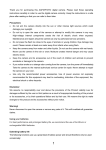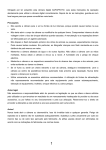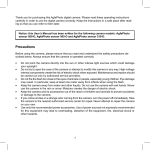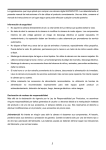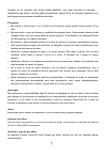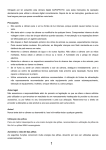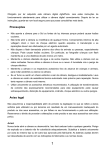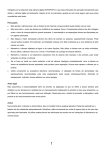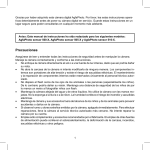Download AGFA DC-1338i User's Manual
Transcript
Thank you for purchasing this AGFAPHOTO digital camera. Please read these operating instructions carefully in order to use the digital camera correctly. Keep the instructions in a safe place after reading so that you can refer to them later. Precautions • Do not aim the camera directly into the sun or other intense light sources which could damage your eyesight. • Do not try to open the case of the camera or attempt to modify this camera in any way. High-voltage internal components create the risk of electric shock when exposed. Maintenance and repairs should be carried out only by authorized service providers. • Do not fire the flash too close to the eyes of animals or people, especially for young children. Eye damage may result. In particular, remain at least one meter away from infants when using flash. • Keep the camera away from water and other liquids. Do not use the camera with wet hands. Never use the camera in the rain or snow. Moisture creates the danger of electric shock. • Keep the camera and its accessories out of the reach of children and animals to prevent accidents or damage to the camera. • If you notice smoke or a strange odor coming from the camera, turn the power off immediately. Take the camera to the nearest authorized service center for repair. Never attempt to repair the camera on your own. • Use only the recommended power accessories. Use of power sources not expressly recommended for this equipment may lead to overheating, distortion of the equipment, fire, electrical shock or other hazards. Disclaimer We assume no responsibility over and above the provisions of the Product Liability Law for damages suffered by the user or third parties as a result of inappropriate handling of the product or its accessories, or by their operational failure and by their use. We reserve the right to make changes to this product and its accessories without prior notice. Warning! Never try to open the camera or to take it apart. This will invalidate all guarantee claims. Danger of explosion if batteries are not changed properly. Only replace the batteries with the same type or another type approved by the manufacturer. Used batteries must be disposed of in accordance with the manufacturer’s guidelines and local regulations. 1 Parts of the Camera 1. Stabilizer 2. Shutter Button 3. Operation Lamp 4. Power Button 5. Speaker 6. Self-timer Lamp / AF Lamp 7. Microphone 8. Lens 9. Flash 10. Zoom Button 11. Playback Button 12. Strap Ring 13. SET/DISP Button / Flash Button / Macro Button 14. Mode Button 15. ASM Button / Delete Button 16. Menu Button 17. LCD Monitor 18. Battery Cover 19. USB/AV Terminal 20. Tripod Socket 2 Inserting the Batteries 1 Open the battery cover. y Slide the battery cover in the direction indicated by the arrow. 2 Insert the batteries. y Install the battery with the terminal facing inside the camera. 3 Close the battery cover. Inserting the Memory Card 1 2 Open the battery cover. Insert the card. y Insert the card with the label facing up and the arrow pointing in. Tips y To remove the card, gently press on the edge of the card and release it. Pull the card out and close the battery cover. 3 Close the battery cover. 3 Changing the Mode You can record images and voices in the REC mode. And using the PLAYBACK mode to replay, delete, or edit images on the LCD monitor. Switching between REC mode and PLAYBACK mode In REC mode: press the PLAYBACK button (n) to switch to the PLAY mode. In PLAY mode: press the PLAYBACK (n) or the MODE (o) button to switch to the REC mode. Selecting the REC mode 1 2 Set the camera to the REC mode. Launch the mode palette. y Press the MODE button to show the scene mode palette. 3 Select a mode. y Use the four-way control to select a desired mode and press the SET button to confirm the setting. Selecting the ASM mode 1 Set the camera to the REC mode. y It cannot be switch to ASM mode while in Movie or Voice REC mode. 2 Launch the ASM mode. y Press the ASM button (n) to toggle switch between Aperture Priority, Shutter Priority, Manual Exposure mode. 4 Using the Menus When a menu is displayed, the four-way control and the SET button are used to make the desired settings. REC menu 1 Turn the power on, and set the camera to the REC mode. 2 Open the REC menu. y Press the MENU button to display the menu. 3 Select an item. y 4 or to select a menu item. Change the setting. y 5 Press Press or to change the setting. Press the MENU or the SET button to save the settings and close the menu. Setup menu 1 Turn the power on, and set the camera to the REC or PLAYBACK mode. 2 Press the MENU button to open the REC or PLAYBACK menu. y The menu displays depends on whether you are in the REC mode or the PLAY- BACK mode. 3 Open the Setup menu. y Press four-way control to select SETUP ( display the Setup menu. 5 ) and then press the SET button to 4 Select an item. y Press or to select a menu item and then press or the SET button to launch the submenu. 5 Change the setting. y Press or to select an option and press or the SET button to apply the setting. 6 Press the MENU button to close the menu. Using the Stabilizer With more sensibility and faster shutter speed to bright up the pictures, effectively prevent blur image caused by hand shack or target movement. Playing Back Images 1 2 Turn the power on, and set the camera to the PLAYBACK mode. y The latest recorded image appears on the LCD monitor. y If there are no images stored, a message [No image] appears. Press the four-way control or y : displays the previous image. y : displays the next image. . 6 Customer care More information con the complete AGFAPHOTO digital camera product range can be found under www.plawa.com Service & Repair Hotline (EU): 00800 752 921 00 (from a landline only) Service & Support Hotline (Germany): 0900 1000 042 (1.49 Euro/ min. from a German landline only) Online Service / International contact: [email protected] Manufactured by plawa-feinwerktechnik GmbH & Co. KG Bleichereistraße 18 73066 Uhingen Germany AGFAPHOTO is used under license of Agfa-Gevaert NV & Co. KG. Agfa-Gevaert NV & Co. KG. does not manufacture this product or provide any product warranty or support. For service, support and warranty information, contact the distributor or manufacturer. Contact: AgfaPhoto Holding GmbH, www.agfaphoto.com Disposal of Waste Equipment by Users in Private Households in the European Union This symbol on the product or on its packaging indicates that this product must not be disposed of with your other household waste. Instead, it is your responsibility to dispose of your waste equipment by handing it over to a designated collection point for the recycling of waste electrical and electronic equipment. The separate collection and recycling of your waste equipment at the time of disposal will help to conserve natural resources and ensure that it is recycled in a manner that protects human health and the environment. For more information about where you can drop off your waste equipment for recycling, please contact your local city office, your household waste disposal service or the shop where you purchased the product. 7 Batteries and rechargeable batteries should not be thrown in the trash can. Please return used batteries to the store or take it to where they collets such items. Following this guideline we are helping not to polluting our environment. Declaration of Conformity We herewith confirm the following designated product: AGFAPHOTO digital camera DC-1338i has been tested and found to comply with the requirements set up in the council directive on the approximation of the law of members’ states relating to the EMC Directive 2004/108/EC. For the evaluation regarding to the electromagnet compatibility, the following standards were applied EN 55022:2006, Class B EN 55024:1998+A1:2001+A2:2003 IEC 61000-3-2:2005 IEC 61000-4-2:2001 IEC 61000-3-3:2005 IEC 61000-4-3:2006 IEC 61000-4.4: 2004 IEC 61000-4-5:2005 IEC 61000-4-6:2006 IEC 61000-4-8:2001 IEC 61000-4-11:2004 The device is marked with CE Logo. FCC Compliance and Advisory This device complies with Part 15 of the FCC Rules. Operation is subject to the following two conditions: 1.) this device may not cause harmful interference, and 2.) this device must accept any interference received, including interference that may cause unsatisfactory operation. This equipment has been tested and found to comply with the limits for a Class B peripheral, pursuant to Part 15 of the FCC Rules. These limits are designed to provide reasonable protection against harmful interference in a residential installation. This equipment generates, uses, and can radiate radio frequency energy and, if not installed and used in accordance with the instructions, may cause harmful interference to radio communication. However, there is no guarantee that interference will not occur in a particular installation. If this equipment does cause harmful interference to radio or television reception, which can be determined by turning the equipment off and on, the user is encouraged to try to correct the interference by one or more of the following measures. • Reorient or relocate the receiving antenna. • Increase the separation between the equipment and receiver. 8 • Connect the equipment to an outlet on a circuit different from that to which the receiver is connected. • Consult the dealer or an experienced radio/TV technician for help. Any changes or modifications not expressly approved by the party responsible for compliance could void the user’s authority to operate the equipment. When shielded interface cables have been provided with the product or when specified additional components or accessories have elsewhere been designated to be used with the installation of the product, they must be used in order to ensure compliance with FCC regulations. 9









